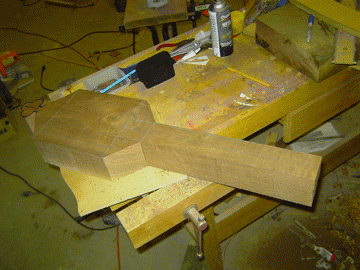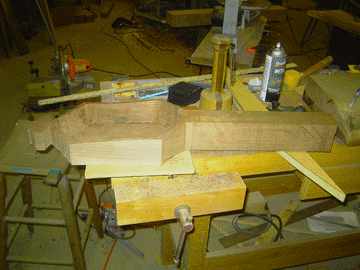14th Century Citole
The citole is a predecessor of the guitar, it is a plucked instrument
from the 11th century. The citole had no particular set
shape or size, but like the rebec, the body and neck were carved from
one single piece of wood.
I have loosely based my citole on the Warwick Castle instrument, the
only extant citole. It has some design features that I agree are
significant, and thus I am putting these features into my instrument.
It was built as a citole in the 14th century, but converted for
Queen Elizabeth in the 16th century into a violin. This is one of
the most fascinating, and to me personally, ugly, instruments ever made.
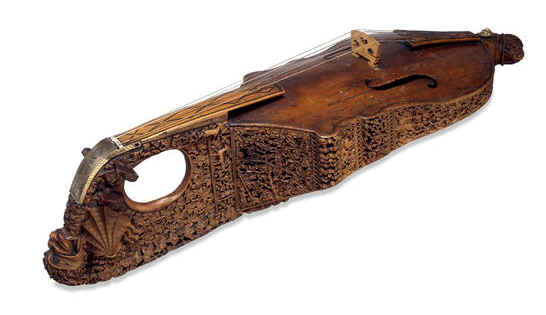
I am building this citole not to perfect the medieval method of
building a citole, but to learn what goes into building a functional
citole. Therefore there are a few things that I will do with
modern tools to help get this project moving. However, since I
enjoy doing it, most of the work (with the exception of the gross
cutting and hollowing) will be done with appropriate hand tools.
I am going to display my progress in this project on a daily basis -
construction shots of each day's progress. Today, the first day
of construction, is Monday, November 7, 2005. I am hoping to have
this instrument done by November 19th, and playing at Crystal Ball.
I am not using any plans, standard dimensions, or measured drawings in
this project - I believe most instruments built in this period were
built well, and with an understanding of the instrument, but still
following a basic "cut it down, hollow it out, glue it together, and
play it" attitude. Sure, there were great instrument builders,
but many instruments were built by those who would play them, and this
is the type of instrument I want to create.
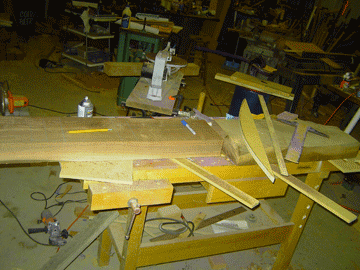 Start
with a hunk of wood, and see where the instrument is hiding in
it. This is 85 tear old English Walnut. A big plank, from
my Grandfather's stock (I was given it upon his death). It is a
strangely figured and flawed piece, but there is a citole in there
somewhere - yup, found it.
Start
with a hunk of wood, and see where the instrument is hiding in
it. This is 85 tear old English Walnut. A big plank, from
my Grandfather's stock (I was given it upon his death). It is a
strangely figured and flawed piece, but there is a citole in there
somewhere - yup, found it.
Laying out the
lines. This instrument will be somewhere between 28 and 30 inches
total length, with a holly leaf shaped body.
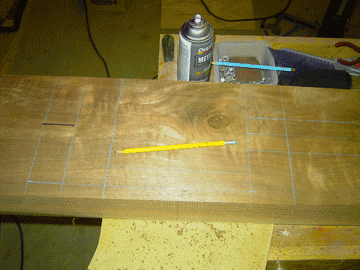
Basic layout, time
to start cutting. The knot was only half way through the board,
so I put it in the part that had to be hollowed out.
Rough cut and shaped, lots of removal left
before this thing will even start to resemble a citole. It is
much lighter now, but still heavy
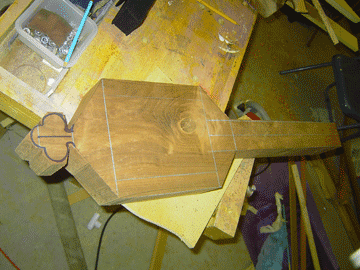
From the front view, showing the trefoil that will hold the
tailgut. One feature of the Warwick citole that I think is a fine
idea - holds the strings and provides a handle. So it is included
on mine.
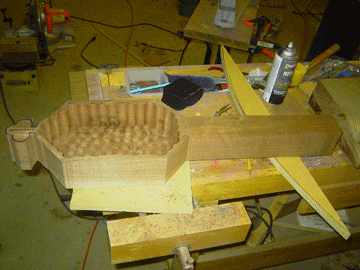
Hogging out the body. After rough cutting the body and finding no
hidden flaws, I used a large forstner bit to remove the wood
fast. Now for chiseling, scraping, and sanding.
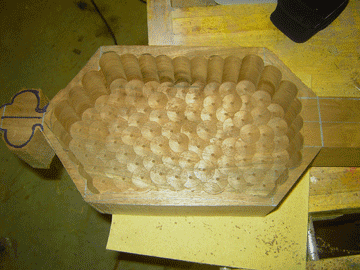
Top view of the body being hogged out. Forstner bits make
interesting patterns, y'know?
Tapering the
soundbox. The soundbox is tapered to the front, the instrument
has a high bridge more like a violing than a guitar, and the
fingerboard is horizontal. So the body is thinner at the front
than at the rear, so that the bridge will be at the height of the
fingerboard.
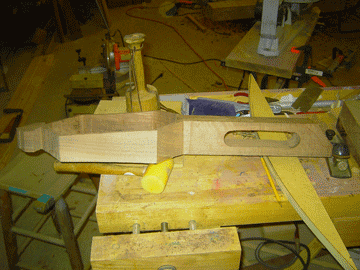
Now the thumbslot
is cut. This allows you to play the instrument and still leaves
enough wood on the neck to prevent warping and bending (they didn't
have adjustable truss rods for instrument necks in the 14th
century). This is the basic shape of the instrument - lots of
detail tweaking, but this is the basic shape.
This is the end of day 1. More tomorrow (Tuesday, Nov 8)
Day 1
Day 2 Day 3 Day 4 Day 5 Day 6
Day 7
Day 8
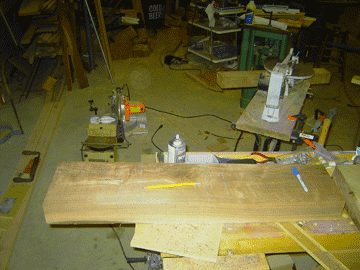

 Start
with a hunk of wood, and see where the instrument is hiding in
it. This is 85 tear old English Walnut. A big plank, from
my Grandfather's stock (I was given it upon his death). It is a
strangely figured and flawed piece, but there is a citole in there
somewhere - yup, found it.
Start
with a hunk of wood, and see where the instrument is hiding in
it. This is 85 tear old English Walnut. A big plank, from
my Grandfather's stock (I was given it upon his death). It is a
strangely figured and flawed piece, but there is a citole in there
somewhere - yup, found it.

